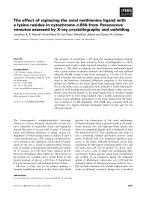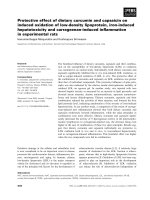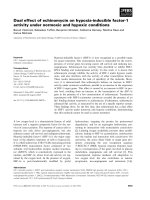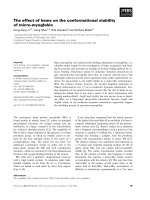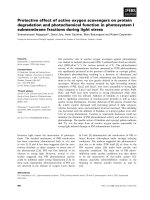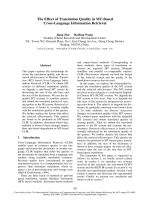Báo cáo khoa học: " Antibacterial Effect of Bovine Lactoferrin Against Udder Pathogen" doc
Bạn đang xem bản rút gọn của tài liệu. Xem và tải ngay bản đầy đủ của tài liệu tại đây (92.3 KB, 8 trang )
Kutila T, Pyörälä S, Saloniemi H, Kaartinen L: Antibacterial effect of bovine lacto-
ferrin against udder pathogens. Acta vet. scand. 2003, 44, 35-42. – The antibacterial
effect of lactoferrin (Lf) was tested on isolates of Escherichia coli (E. coli), Staphylo-
coccus aureus (S. aureus), and coagulase-negative staphylococci (CNS) as well as on
Pseudomonas aeruginosa (P. aeruginosa) and Klebsiella pneumoniae (K. pneumoniae),
originally isolated from bovine mastitis. Concentrations of Lf used were 0.67 mg/ml,
1.67 mg/ml, and 2.67 mg/ml. Growth of udder pathogens was monitored by turbidome-
try either in broth culture or in whey prepared from normal milk. We focused on 3 dif-
ferent growth variables: lag time, slope, and maximum absorbance of bacterial growth
curves. Growth inhibition was seen in the broth but hardly at all in whey. The isolates of
E. coli and CNS did not grow sufficiently well in whey to draw any conclusions. The
most effective inhibitory activity of Lf was seen against E. coli and P. aeruginosa. All 5
E. coli isolates had similar growth patterns. Inhibition of growth by Lf was concentra-
tion-dependent. The concentration of 0.67 mg/ml in broth and whey was generally too
low for a significant inhibitory effect.
mastitis pathogens; growth inhibition.
Acta vet. scand. 2003, 44, 35-42.
Acta vet. scand. vol. 44 no. 1-2, 2003
Antibacterial Effect of Bovine Lactoferrin Against
Udder Pathogens
By T. Kutila
1
, S. Pyörälä
1
, H. Saloniemi
1
, and L. Kaartinen
2
1
Faculty of Veterinary Medicine, Department of Clinical Veterinary Science, University of Helsinki, and
2
National Agency for Medicines, Helsinki, Finland.
Introduction
Lactoferrin (Lf) is an iron-binding glycoprotein
found in milk, other external secretions, and the
granules of neutrophilic polymorphonuclear
leukocytes (Baggiolini et al. 1970, Masson et
al. 1966, 1969). Lf has been shown to be bacte-
riostatic in vitro, and this inhibitory activity is
believed to be the result of the powerful iron-
chelating ability of Lf, making iron unavailable
to bacteria (Reiter & Oram 1967, Weinberg
1978). Lactoferrin has a broad-spectrum an-
timicrobial activity against Escherichia coli,
Staphylococcus aureus, Bacillus subtilis, Kleb-
siella pneumoniae, Streptococcus mutans and
Candida albicans, among others (Arnold et al.
1980, Lonnerdal & Iyer 1995). Lf has also been
shown to enhance the activity of some antimi-
crobials in vitro (Sanchez & Watts 1999, Diarra
et al. 2002).
Evidence from a number of studies indicates
that the antimicrobial activity of Lf is more
complex than simple Fe chelation. Lf has bac-
tericidal activity and can kill susceptible bacte-
ria by a mechanism distinct from sequestering
of Fe (Arnold et al. 1980, Dalmastri et al. 1988,
Ellison et al. 1988, 1990). Bellamy et al. (1992)
established that the antimicrobial domain is
near the N-terminus of Lf in a region distinct
from its iron-binding sites. Apo-Lf (iron-free
Lf) was shown to increase bacterial cell mem-
brane permeability and directly damage the
outer membrane of Gram-negative bacteria (El-
lison et al. 1988, 1990).
Normal bovine milk contains low concentra-
tions of Lf, approximately 0.1 mg/ml or less,
but in dry udder secretion Lf concentration is
markedly higher and can reach a level of 20
mg/ml or higher (Schanbacher et al. 1997,
Welty 1976). During the dry period, the udder is
very resistant to coliform infections, mostly
due to the high Lf content of the secretion
(Oliver & Bushe 1987). In mastitic cows, Lf
concentrations of the milk have been shown to
increase dramatically and can range from 0.3
mg/ml to 2.3 mg/ml (Harmon et al. 1976,
Kawai et al. 1999).
Lf may have therapeutic potential in mastitis
(Diarra et al. 2002, Lohuis et al. 1995). It could
partly replace the use of antimicrobials, which
cause problems due to residues in milk and the
risk for emergence of resistance. Studies on the
in vitro susceptibility of udder pathogens to Lf
are, however, scant. The aim of this study was
to determine the antibacterial activity of Lf
against bovine udder pathogens in vitro.
Materials and methods
Lactoferrin
Bovine Lf was purified from cheese whey or
concentrated cheese whey by the expanded bed
absorption chromatography method (Isomäki
1999). Iron content of native Lf was approxi-
mately 8%-15% (Isomäki 1999). Lf was stored
frozen at -20°C and sterile-filtered (32 mm
Acrodisc PT Syringe Filters 0.8/0.2 µm, Gel-
man Laboratory REF: 4658) before use. The
final concentration of Lf in the product was
35.5 mg/ml (Isomäki 1999). Purity of Lf was
tested in SDS-page (sodium dodecyl sulphate
polyacrylamide gel electrophoresis) (Isomäki
1999). Apo-Lf was prepared from Lf by citrate
dialyzing (Dionysius et al. 1993), and its iron
content was approximately 4%.
Growth media
Two growth media were used for bacterial cul-
tures: the commercial Iso Sensitest-Broth (ISB
CM473, Oxoid Ltd., Basingstoke, Hampshire,
England), and whey. Whey was prepared from
3 liters of fresh raw milk obtained from the uni-
versity dairy herd by high-speed centrifugation
of defatted milk (32600 g for 60 min at 4°C).
Aliquots of 40-ml whey were sterile-filtered
and frozen immediately after preparation for
later use.
Bacterial isolates and the preparation of
inoculums
Five isolates of E. coli, S. aureus, and coagulase
negative-staphylococci (CNS), 2 isolates of P.
aeruginosa and 2 isolates of K. pneumoniae
originally isolated from subclinical or clinical
cases of bovine mastitis were used. These iso-
lates were received from the mastitis laboratory
of the Faculty of Veterinary Medicine and the
National Veterinary and Food Research Insti-
tute, Helsinki. One of the S. aureus isolates was
the reference isolate M60 kindly provided by
Dr. A. J. Guidry (Immunology and Disease Re-
sistance Laboratory USDA, Beltsville, USA).
During the experiment, bacteria were main-
tained on blood agar plates at 8°C. To adapt the
bacterial isolates to grow in whey, they were
grown overnight at 37°C in a growth medium
consisting of 2/3 Iso Sensitest-Broth and 1/3
sterile whey. The cultures were tested using
Gram-staining for purity. Bacteria were har-
vested by centrifugation (5000 g for 10 min)
and washed twice between centrifugations us-
ing sterile saline (0.9% NaCl, 20°C). A suspen-
sion containing approximately 10
9
colony-
forming units (CFU) in 0.9% NaCl was
prepared according to the McFarland standard
(bioMérieux sa, 69280 Marcy I´Etoile, France)
by spectrophotometry (550 nm, Hitatchi U-
2000, Hitachi, Ltd., Tokyo, Japan). Bacterial
suspension was diluted to the final concentra-
tion of 1.5×10
3
CFU/ml used in each well.
Analysis of bacterial growth by turbidometry
Bacterial growth was measured using tur-
bidometry (Bioscreen instrument, Labsystems,
Helsinki, Finland). The instrument is a fully au-
36 T. Kutila et al.
Acta vet. scand. vol. 44 no. 1-2, 2003
tomated analyzing system for measuring bacte-
rial growth using the vertical light bath with
wide band absorption principle; 200 individual
samples can be run simultaneously. Each well
contained 100 µl of ISB broth or 150 µl of whey
as the growth medium, 50 µl of bacterial sus-
pension, and 50 µl of Lf concentrate. Physio-
logical saline was added to bring the final vol-
ume to 300 µl: 50 µl and 100 µl in ISB and whey
wells, respectively. Tested amounts of Lf were
200 µg (the final Lf concentration in the well
was 0.67 mg/ml), 500 µg (1.67 mg/ml), and 800
µg (2.67 mg/ml). Control wells contained all
components except Lf, which was replaced by
50 µl of 0.9% saline. Five parallel wells were
used. Wells between whey and ISB wells were
filled with 0.9% NaCl to prevent cross-contam-
ination. The wells on 2 100-well plates were
covered and preincubated in the Bioscreen in-
strument for 30 min at 37°C. The change in tur-
bidity was monitored automatically every hour
for 20 h at 37°C. The plates were shaken 10 min
before each measurement. Two E. coli and 2 S.
aureus isolates were also tested with Apo-Lf.
The lag time (time from beginning of incuba-
tion until the time-point when absorbance be-
gan to increase), slope (slope of the growth
curve in logarithmic growth phase), and maxi-
mum absorbance (highest absorbance value
measured during the 20-h period) were used as
variables describing the bacterial growth. After
the 20-h incubation period, bacterial survival
and bactericidal effect of Lf in the wells were
confirmed by culturing aliquots of 10 ml on
blood agar plates and incubating the plates
overnight at 37°C.
Antibacterial effect of bovine lactoferrin 37
Acta vet. scand. vol. 44 no. 1-2, 2003
Table 1. Effect of Lf on bacterial growth in ISB culture, measured by lag time and maximum absorbance.
Lag time (h) Maximum absorbance
Bacteria Mean Min-max SD Mean Min-max SD
Escherichia coli (n=5)
Control 3.8 3.0-4.0 0.45 0.91 0.70-1.05 0.15
0.67 mg/ml Lf 6.6 5-9 1.52 0.67 * 0.57-0.73 0.06
1.67 mg/ml Lf 9.0 5-15 4.1 0.52 * 0.25-0.70 0.18
2.67 mg/ml Lf 10.6 6.0-20.0 6.0 0.42 * 0.11-0.68 0.24
Staphylococcus aureus (n=5)
Control 4.8 4.0-5.0 0.45 0.60 0.49-0.65 0.07
0.67 mg/ml Lf 7.2 5.0-11 2.4 0.55 0.42-0.69 0.11
1.67 mg/ml Lf 8.4 * 6.0-12 2.2 0.52 0.40-0.66 0.10
2.67 mg/ml Lf 8.4 * 6.0-12 2.2 0.49 * 0.40-0.64 0.10
Coagulase-negative
staphylococci (n=5)
Control 6.4 5.0-10 2.2 0.56 0.53-0.60 0.03
0.67 mg/ml Lf 12.2 6.0-20 7.2 0.36 0.10-0.56 0.23
1.67 mg/ml Lf 12.2 6.0-20 2.2 0.34 0.11-0.52 0.21
2.67 mg/ml Lf 12.4 7.0-20 7.0 0.34 0.10-0.55 0.21
Lag time = time from the beginning of incubation until the time-point when the absorbance began to increase; maximum
absorbance = highest absorbance value measured during the 20-h incubation period.
Statistically significant difference when compared with negative control: * p ≤0.05
Statistical methods
The effect of different Lf concentrations on lag
time, slope, and maximum absorbance was
tested by repeated measures analysis of vari-
ance with concentration as a within factor. The
significance of concentration was evaluated by
Greenhouse-Geisser adjusted p-values. Con-
centrations of 0.67, 1.67, and 2.67 mg/ml of Lf
were further compared with a negative control.
Results
Results of growth inhibition by Lf in ISB for E.
coli, S. aureus, and CNS are shown in Table 1.
The best inhibitory activity of Lf in the ISB was
seen against E. coli and P. aeruginosa (data not
shown for the latter). The typical growth curves
of E. coli in the ISB broth with different con-
centrations of Lf are shown in Fig. 1. The in-
hibitory effect of Lf for E. coli was concentra-
tion-dependent (Fig. 2), and variation between
the 5 isolates of E. coli was small. None of the
isolates was totally resistant to Lf. The effect of
Lf on the maximum absorbance and the slope
of E. coli in ISB was statistically significant
(p = 0.025 and p<0.001, respectively), whereas
the effect on the lag time was not significant
(p = 0.065).
The growth of 2 isolates of P. aeruginosa was
clearly inhibited in ISB. In contrast, the growth
of 2 K. pneumoniae isolates was hardly inhib-
ited at all. In whey, K. pneumoniae showed vari-
able susceptibility and the results were contra-
dictory (data not shown).
The isolates of CNS and S. aureus in ISB
showed more variation to Lf than E. coli. Lf had
significant effects on lag time (p = 0.014) and
maximum absorbance (p = 0.014) of S. aureus,
while no significant effects were seen for CNS
(Table 1). As regards the slope, a statistically
significant difference was present between Lf
38 T. Kutila et al.
Acta vet. scand. vol. 44 no. 1-2, 2003
Figure 1. Growth curves of E. coli FT238 in Iso Sensitest-Broth (ISB) with concentrations of 0.67, 1.67, and
2.67 mg/ml lactoferrin (Lf) and without Lf.
concentration and the control in the growth of
S. aureus (p = 0.001) and CNS (p = 0.002). The
growth of four CNS isolates was somewhat in-
hibited by Lf, but one was totally resistant.
Three isolates of S. aureus were more suscepti-
ble to Lf than the 2 other isolates at 0.67 mg/ml
of Lf. The results for S. aureus in whey are pre-
sented in Table 2. Lf concentration had a sig-
nificant inhibitory effect on lag time (p =
0.015), maximum absorbance (p = 0.011), and
slope (p = 0.027) of S. aureus in whey. The ini-
tial absorbancies in whey wells were higher
than in ISB cultures (~1.0) because whey is
more turbid than ISB. The growth of E. coli, P.
aeruginosa, and CNS isolates was so poor in
normal whey that it was not possible to draw
any conclusions about the effect of Lf in that
medium.
Two isolates of E. coli and 2 isolates of S. au-
reus were also tested with Apo-Lf in ISB. The
results were similar to those of native Lf (data
not shown).
Discussion
Our results demonstrate that bovine Lf in vitro
is bacteriostatic towards some udder pathogens.
The most interesting finding was the clear in-
hibitory activity of Lf against E. coli, which is
in agreement with many previous studies
(Dionysius et al. 1993, Nonnecke & Smith
1984, Rainard 1986). Unfortunately, the most
Antibacterial effect of bovine lactoferrin 39
Acta vet. scand. vol. 44 no. 1-2, 2003
Table 2. Effect of Lf on the growth of S. aureus in whey culture, measured by lag time and maximum ab-
sorbance. The initial absorbancies in whey wells were higher than in ISB cultures (~1.0) because whey is more
turbid than ISB. For explanations see Table 1.
Lag time (h) Maximum absorbance
Bacteria Mean Min-max SD Mean Min-max SD
Staphylococcus aureus (n=5)
Control 10.6 8.0-13 1.82 1.66 1.12-2.22 0.48
0.67 mg/ml Lf 14.2 8.0-20 5.6 1.23 * 0.95-1.59 0.27
1.67 mg/ml Lf 16.8 * 10-20 4.6 1.05 * 0.87-1.28 0.16
2.67 mg/ml Lf 20 ** - *
- = no bacterial growth
Statistically significant difference when compared with negative control:
* p <0.05 ** p <0.01
Figure 2. Mean and SD of lag time and maximum
absorbance of five E. coli isolates in ISB with con-
centrations of 0.67, 1.67, and 2.67 mg/ml Lf and
without Lf.
important target pathogen, E. coli, was in our
study unable to grow in whey prepared from
bulk milk with low somatic cell count. Rainard
(1986) tested the in vitro susceptibility to Lf of
35 E. coli isolates, which had originally been
isolated from clinical or subclinical bovine
mastitis. He found that most of the isolates were
completely inhibited by 0.1 mg/ml Apo-Lf at
the end of the 16-h incubation period. A few
isolates partially resisted the bacteriostatic ac-
tion of Lf, but none was totally resistant. Non-
necke & Smith (1984) reported bacteriostatic,
but not bactericidal, activity of bovine Lf
against Gram-negative mastitis-causing bacte-
ria E. coli and Kl. pneumoniae. Dionysius et al.
(1993) reported that an Lf concentration of 1.0
mg/ml inhibited growth of all 19 isolates of en-
terotoxigenic E. coli isolated from porcine en-
teritis. The degree of inhibition was strain-de-
pendent. Bacterial killing occurred at relatively
high initial concentrations of bacteria (5 × 10
3
CFU/ml), but bacteriostatic effects were seen
even at higher concentrations. Contradictory
results have also been found; Sanchez & Watts
(1999) did not see effect of Lf alone at concen-
trations from 0.5 to 3 mg/ml on three E. coli
strains isolated from bovine mastitis.
Dionysius et al. (1993) found no significant dif-
ferences in the activity between native (32% Fe)
and Apo-(<1% Fe) Lf. Bhimani et al. (1999)
pointed out that Apo- and Fe-saturated forms of
bovine Lf were equally effective against exper-
imental S. aureus in in vivo infections in mice;
bovine Lf with different degrees of iron satura-
tion (9%-97%) was found to be similar. We
conducted limited testing using Apo-Lf, the re-
sults being comparable with those of native Lf.
However, because Apo-Lf is not a realistic can-
didate for potential use in cows, we focused on
native Lf.
We used whey as a growth medium because it
simulates the environment of the milk compart-
ment of the cow udder. Whey from milk of
healthy cows is known to inhibit the growth of
a number of bacterial species (Maisi et al.
1984). Whey prepared from milk of mastitic
cows may have been a better medium for our
studies, but it would have been difficult to stan-
dardize the medium and compare our results
with those of other authors.
The mechanism by which Lf inhibits bacterial
growth has not been fully elucidated. Early
studies attributed such effects to the acquisition
of essential Fe from the environment, but more
recent findings have implicated wider cell inter-
actions. Lf damages the outer membrane of
bacteria, with a concomitant release of LPS
from Gram-negative bacteria. The ultrastuc-
tural alterations caused by Lf to the bacteria en-
hance the activity of some antimicrobial agents
(Sanchez & Watts 1999, Diarra et al. 2002), and
one approach could be to combine Lf with an-
tibiotics in treating infections. We decided to
test Lf alone to avoid the problems related to the
use antibiotics and to see the real net effect of
Lf against several bacteria species. Diarra et al.
(2002) demonstrated a synergistic effect be-
tween Lf and penicillin against three S. aureus
strains tested. Lf alone showed a weak in-
hibitory activity which agrees with our results.
Lf can also bind LPS and at least partly block its
detrimental effects (Appelmelk et al. 1994).
Zhang et al. (1999) demonstrated in vitro and in
an experimental mouse model that the E. coli
endotoxin-neutralizing capability of human Lf
was derived from a 33-mer synthetic peptide,
lactoferricin. Lf or lactoferricin could poten-
tially be used for the treatment of endotoxin-in-
duced septic shock. Gram-negative bacteria,
mainly E. coli, cause severe mastitis in lactating
cows, which may result in endotoxin shock and
death. Lf could be a potentially useful treatment
for this condition, but its efficacy should be
tested using in vivo studies.
40 T. Kutila et al.
Acta vet. scand. vol. 44 no. 1-2, 2003
Conclusions
The antibacterial effects of Lf could only be
demonstrated in the ISB medium, as bacterial
growth in whey was weak and variable. The
best inhibitory activity of Lf was seen against
Gram-negative E. coli and P. aeruginosa. The
variation in the susceptibility of the 5 isolates of
E. coli to Lf was small, and none of the isolates
was totally resistant. The response of S. aureus
and CNS isolates to Lf was more variable. Our
findings confirm that bovine Lf in vitro is an-
tibacterial towards some major pathogens.
Acknowledgements
We thank our cooperators Riitta Keiski, Liisa Myl-
lykoski, Kimmo Vahtola, Carita Berg, and Päivi
Anttila at the University of Oulu, Finland, who pro-
vided the Lf. We also thank Arto Ketola, M. Sc.
(Soc.), for statistical analysis and Ilkka Saastamoinen
(technician) and Susann Sunqvist (laboratory assis-
tant) for their technical support.
References
Appelmelk BJ, Yun-qing A, Geerts M, Thijs BG, Boer
HA, Maclaren DM, Graaff J, Nuijens JH: Lacto-
ferrin is a lipid A-binding protein. Infect. Immun.
1994, 62, 2628-2632.
Arnold RR, Brewer M, Gauthier JJ: Bactericidal ac-
tivity of human lactoferrin: sensitivity of a vari-
ety of micro-organisms. Infect. Immun. 1980, 28,
893-898.
Baggiolini M, DeDuve C, Masson PL, Heremans JF:
Association of lactoferrin with specific granules
in rabbit heterophil leucocytes. J. Exp. Med.
1970, 131, 559-570.
Bellamy W, Takase M, Yamauchi K, Wakabayshi H,
Kawase K, Tomita M: Identification of the bacte-
ricidal domain of lactoferrin. Biochim. Biophys.
Acta 1992, 1121, 130-136.
Bhimani RS, Vendrov Y, Furmanski P: Influence of
lactoferrin feeding and injection against systemic
staphylococcal infections in mice. J. Appl. Mi-
crob. 1999, 86, 135-144.
Dalmastri C, Valenti P, Vittoriosso P, Orsi N: En-
hanced antimicrobial activity of lactoferrin by
binding to the bacterial surface. Microb. 1988,
11, 225-230.
Diarra MS, Peticlerc D, Lacasse P: Effect of lacto-
ferrin in combination with penicillin on the mor-
phology and the physiology of Staphylococcus
aureus isolated from bovine mastitis. J. Dairy Sci.
2002, 85, 1141-1149.
Dionysius DA, Grieve PA, Milne JM: Forms of lacto-
ferrin: their antibacterial effect on enterotoxi-
genic Escherichia coli. J. Dairy Sci. 1993, 76,
2597-2606.
Ellison RT III, Giehl TJ, LaForse FM: Damage of
outer membrane of enteric gram negative bacte-
ria by lactoferrin and transferrin. Infect. Immun.
1988, 56, 2774-2781.
Ellison RT III, LaForse FM, Giehl TJ, Boose DS,
Dunn BE: Lactoferrin and transferrin damage of
the gram negative outer membare is modulated
by Ca
2+
and Mg
2+
. J. Gen. Microbiol. 1990, 136,
1437-1446.
Harmon RJ, Schanbacher FL, Ferguson LC, Smith
KL: Changes in lactoferrin, immunoglubulin G,
bovine serum albumin, and alpha lactalbumin
during acute experimental and natural coliform
mastitis of cows. Infect. Immun. 1976, 13, 533-
542.
Isomäki R: Separation of whey antimicrobial pro-
teins and development of bovine lactoferrin im-
munoassays. Licenciate thesis. University of
Oulu, 1999, 89 p.
Kawai K, Hagiwara S, Anri A, Nagahata H: Lacto-
ferrin concentration in milk of bovine clinical
mastitis. Vet. Res. Commun. 1999, 23, 391-398.
Lohuis JACM, Hensen SM, Beers H: Effect of lacto-
ferrin and cephapirin, alone and in combination
on growth of E. coli strains from mastitis. 3rd Int.
Mast. Sem. Proc. II 1995, 110-111.
Lonnerdal B, Iyer S: Lactoferrin: molecular structure
and biological function. Ann. Rev. Nutr. 1995,
15, 93-110.
Maisi P, Mattila T, Sandholm M: Mastitis whey - a
good medium for bacteria? Acta vet. Scand.
1984, 25, 297-308.
Masson PL, Heremans JF, Dive C: An iron-binding
protein common to many external secretions.
Clin. Chim. Acta 1966, 14, 735-739.
Masson PL, Heremans JF, Schonne E: Lactoferrin,
an iron-binding protein in neutrophilic leuco-
cytes. J. Exp. Med. 1969, 130, 643-658.
Nonnecke BJ, Smith KL: Inhibition of mastitic bacte-
ria by bovine milk apo-lactoferrin evaluated by in
vitro microassay of bacterial growth. J. Dairy Sci.
1984, 67, 606-613.
Oliver SP, Bushe T: Growth inhibition of Escherichia
coli and Klebsiella pneumoniae during involution
Antibacterial effect of bovine lactoferrin 41
Acta vet. scand. vol. 44 no. 1-2, 2003
of the bovine mammary gland: relation to secre-
tion composition. Am. J. Vet. Res. 1987, 48,
1669-1973.
Rainard P: Bacteriostatic activity of bovine milk
lactoferrin against mastitic bacteria. Vet. Microb.
1986, 11, 387-392.
Reiter B, Oram JD: Bacterial inhibitors in milk and
other biological fluids. Nature (Lond.) 1967, 216,
328-330.
Sanchez MS, Watts J: Enhancement of the activity of
novobiocin against Escerichia coli by lactoferrin.
J. Dairy Sci. 1999, 82, 494-499.
Schanbacher FL, Talhouk RS, Murray FA: Biology
and origin of bioactive peptides in milk. Live-
stock Prod. Sci. 1997, 50, 105-123.
Weinberg ED: Iron and infection. Mikrob. Rev. 1978,
42, 45-66.
Welty FK, Smith KL, Schanbacher FL: Lactoferrin
concentration during involution of the bovine
mammary gland. J. Dairy Sci. 1976, 59, 224-231.
Zhang G-H, Mann DM, Tsai C-M: Neutralization of
endotoxin in vitro and in vivo by a human lacto-
ferrin-derived peptide. Infect. Immun. 1999, 67,
1353-1358.
Sammanfattning
Antibakteriell effekt av bovint laktoferrin på juverpa-
togener.
Den antibakteriella effekten av laktoferrin (Lf) testa-
des på isolat av Escherichia coli (E. coli), Staphylo-
coccus aureus (S. aureus) och koagulas-negativa
stafylokocker (KNS), samt på Pseudomonas
aeruginosa (P. aeruginosa) och Klebsiella pneumo-
niae (K. pneumoniae) som ursprungligen isolerats
från bovin mastit. Lf-koncentrationer på 0.67 mg/ml,
1.67 mg/ml och 2.67 mg/ml användes. Tillväxten av
juverpatogener övervakades med turbidometri an-
tingen i buljongkultur eller i vassle framställd ur nor-
mal mjölk. Vi fokuserade på 3 olika tillväxtvariabler:
retardationstid, lutning och maximal absorbans för
bakteriernas tillväxtkurvor. En tillväxthämning ob-
serverades i buljong men knappt alls i vassle.
Tillväxten av E. coli och KNS-isolaten i vassle var
inte tillräcklig för att kunna dra några slutsatser. Den
effektivaste hämmande Lf-aktiviteten observerades
emot gram-negativa bakterier, förutom K. pneumo-
niae. Alla fem E. coli-isolat uppvisade liknande
tillväxtmönster. Den tillväxthämmande effekten av
Lf var beroende av koncentrationen. Generellt sett
var 0.67 mg/ml en för låg koncentration i buljong-
kultur och vassle för att uppnå en signifikant häm-
mande effekt.
42 T. Kutila et al.
Acta vet. scand. vol. 44 no. 1-2, 2003
(Received January 10, 2003; accepted January 12, 2003).
Reprints may be obtained from: H. Saloniemi, Faculty of Veterinary Medicine, Department Clinical Veterinary
Science, P.O. Box 57, FIN-00014 Helsinki University, Finland. E-mail: hannu.saloniemi@helsinki.fi, tel: +358
9 19149528, fax: +358 9 191 49799.



